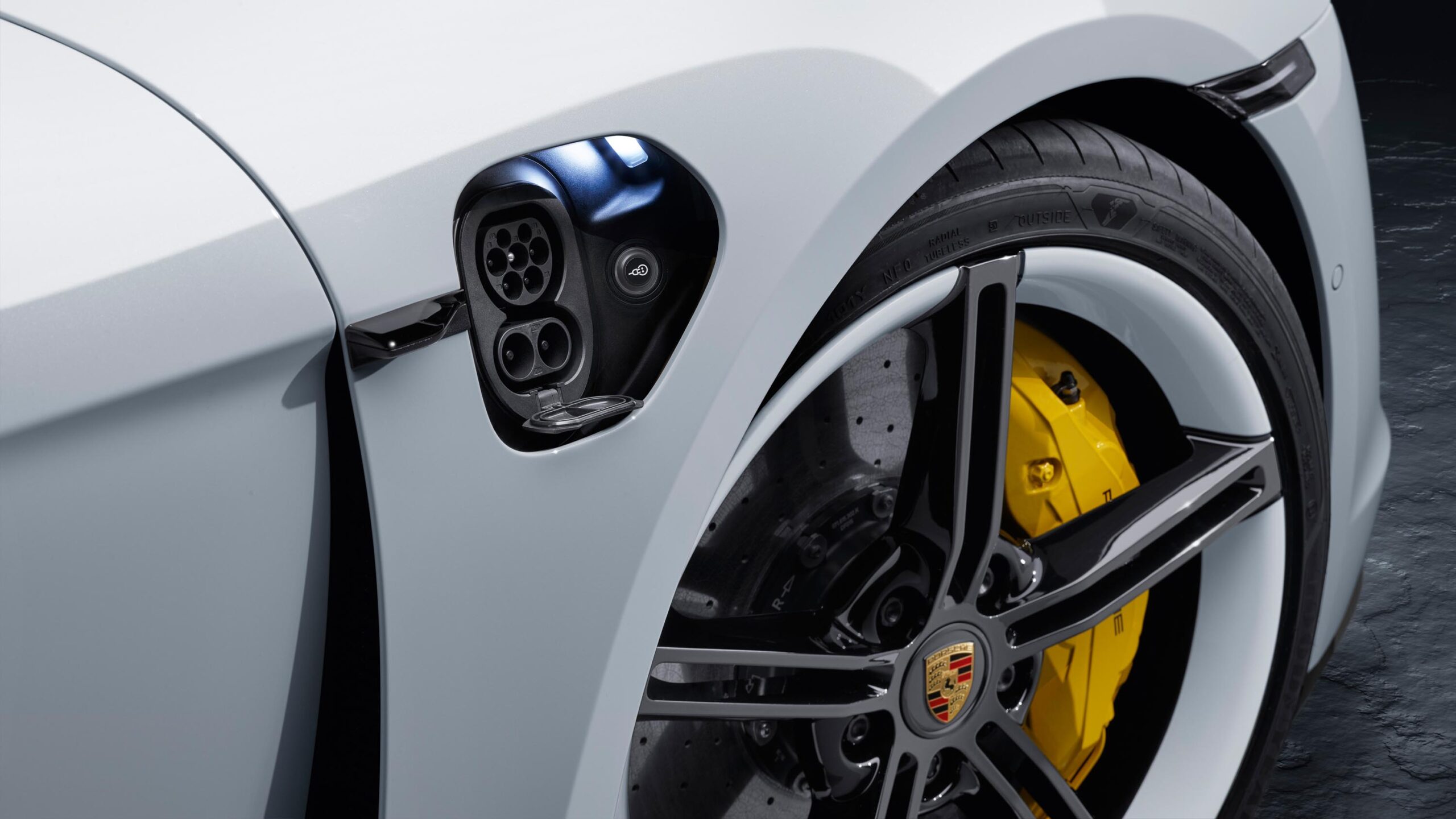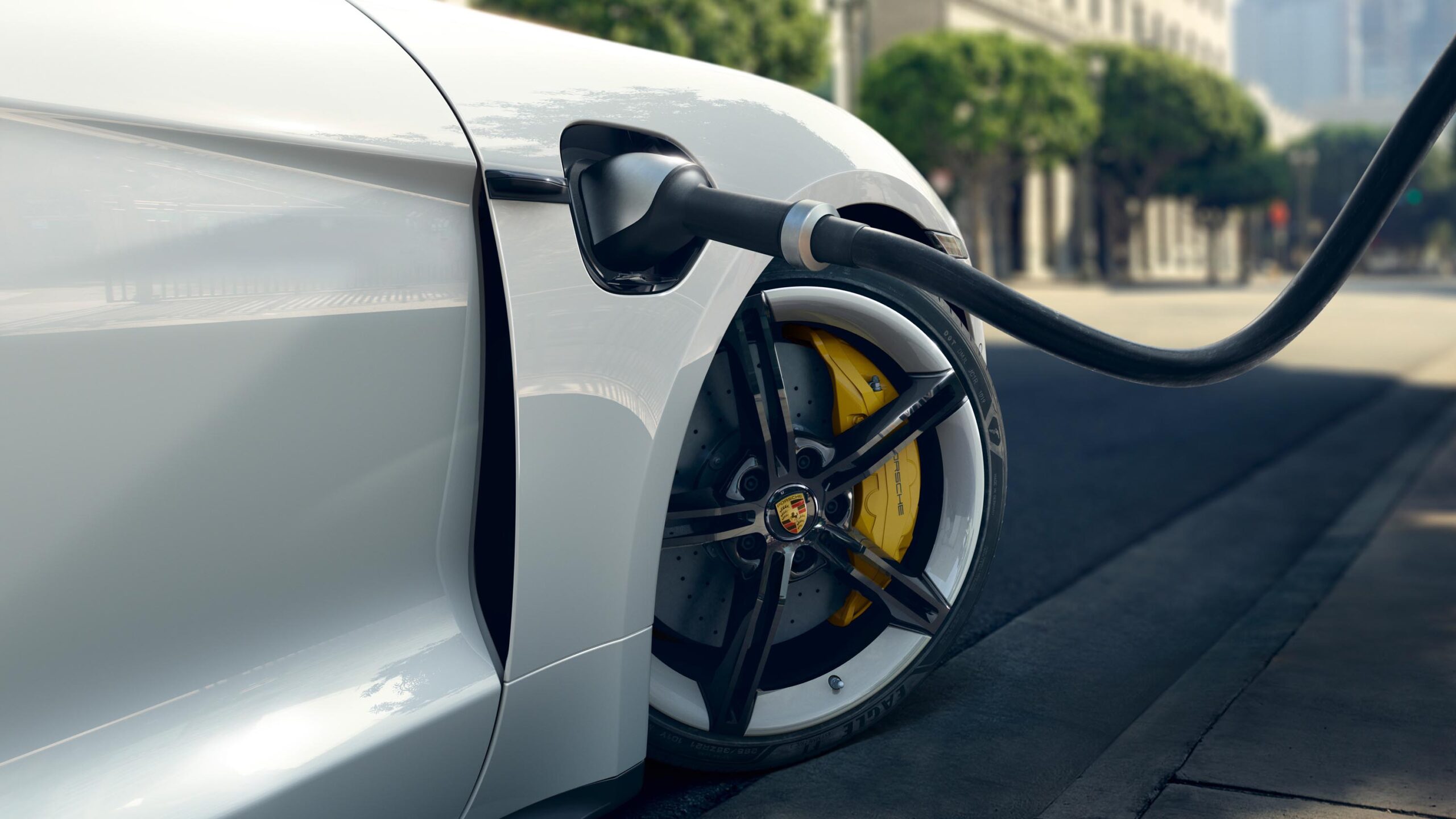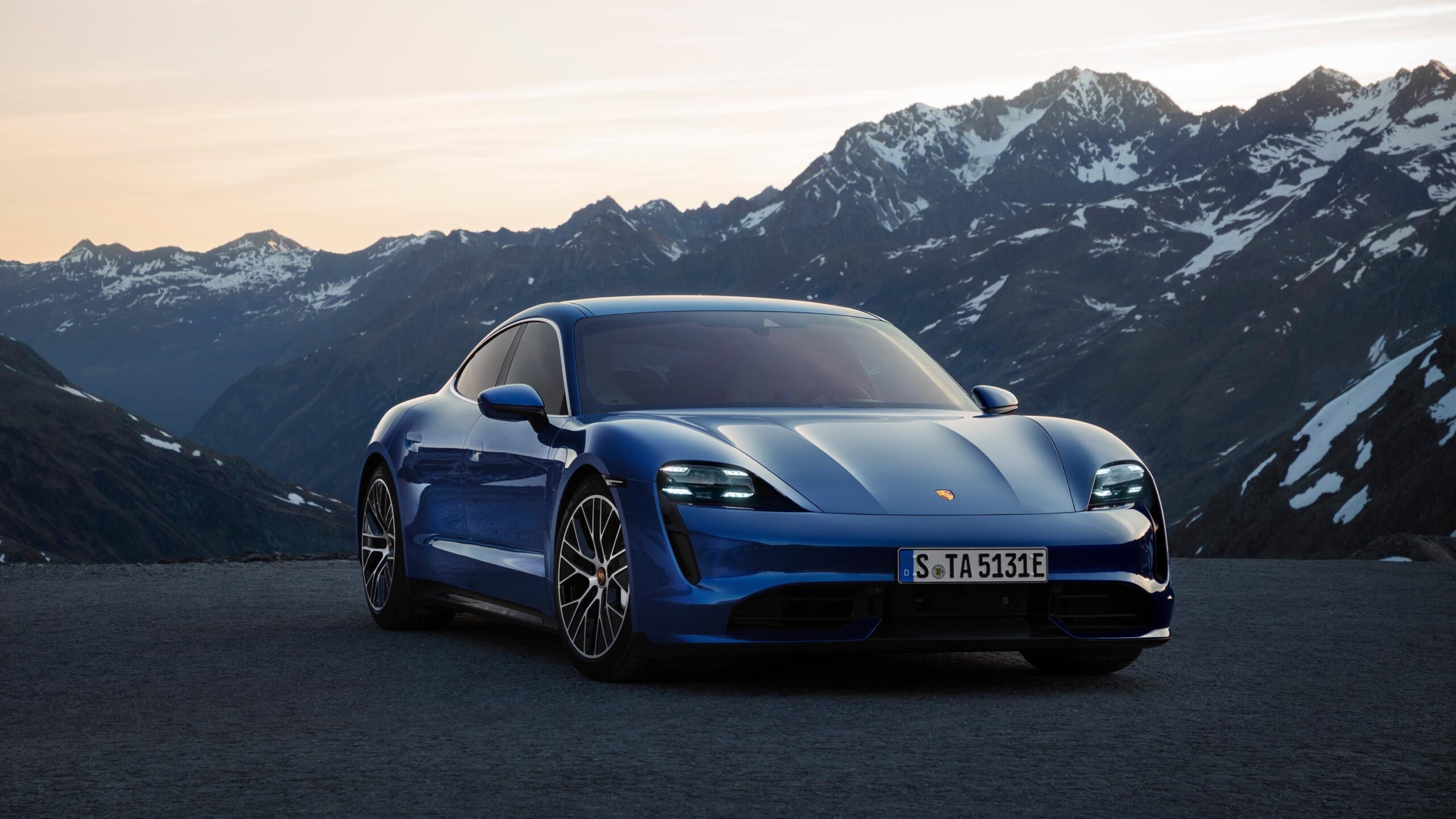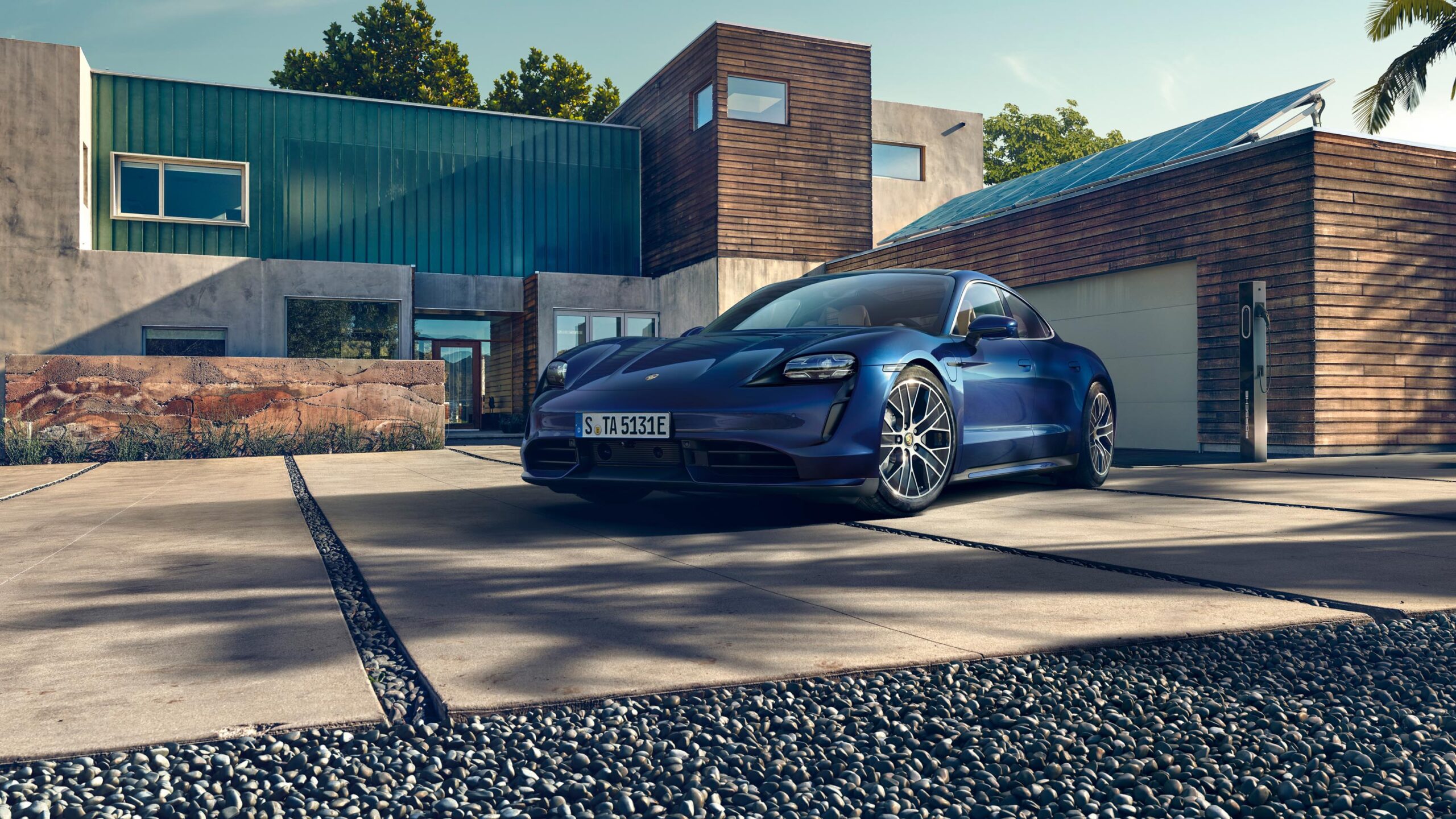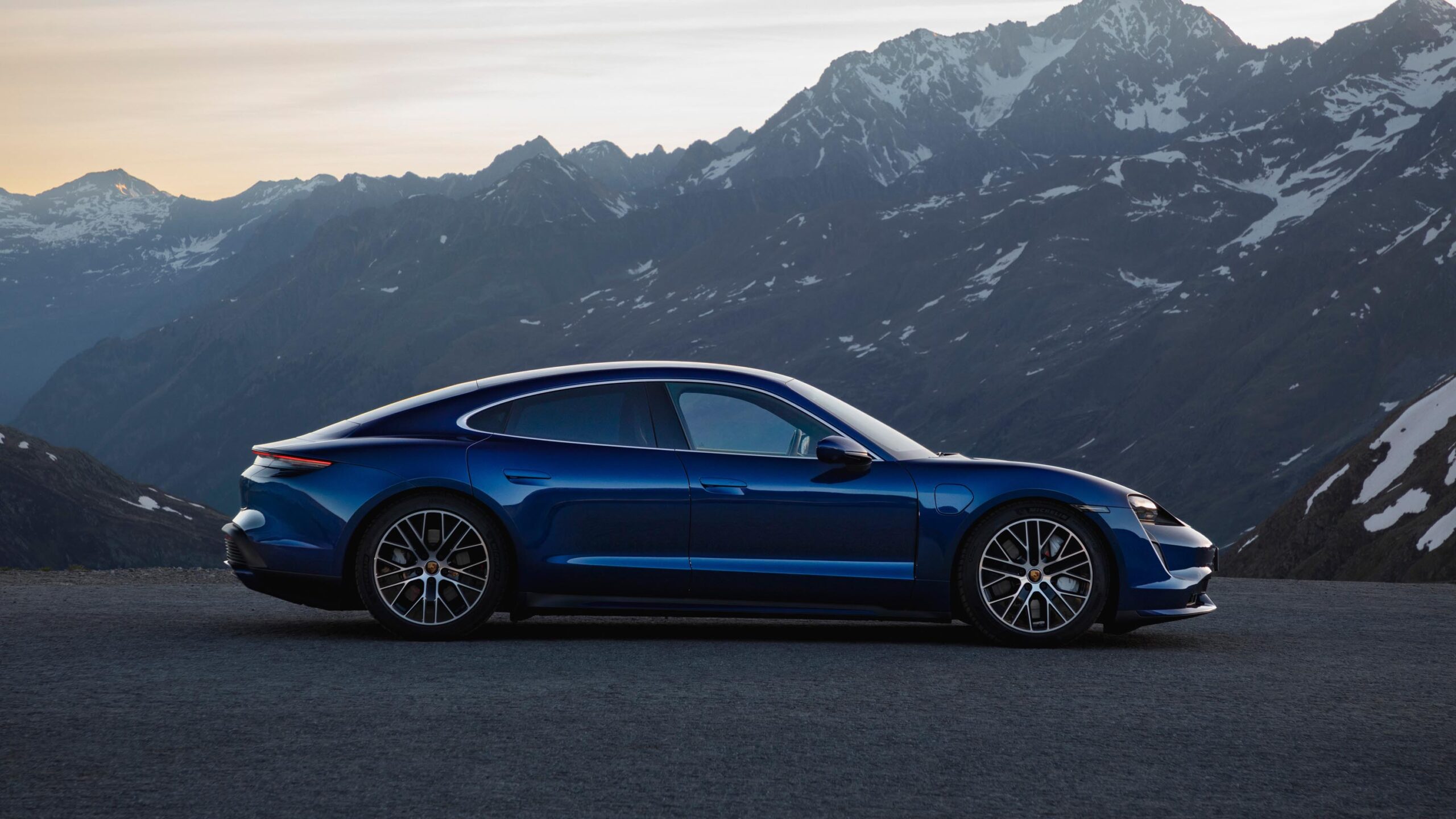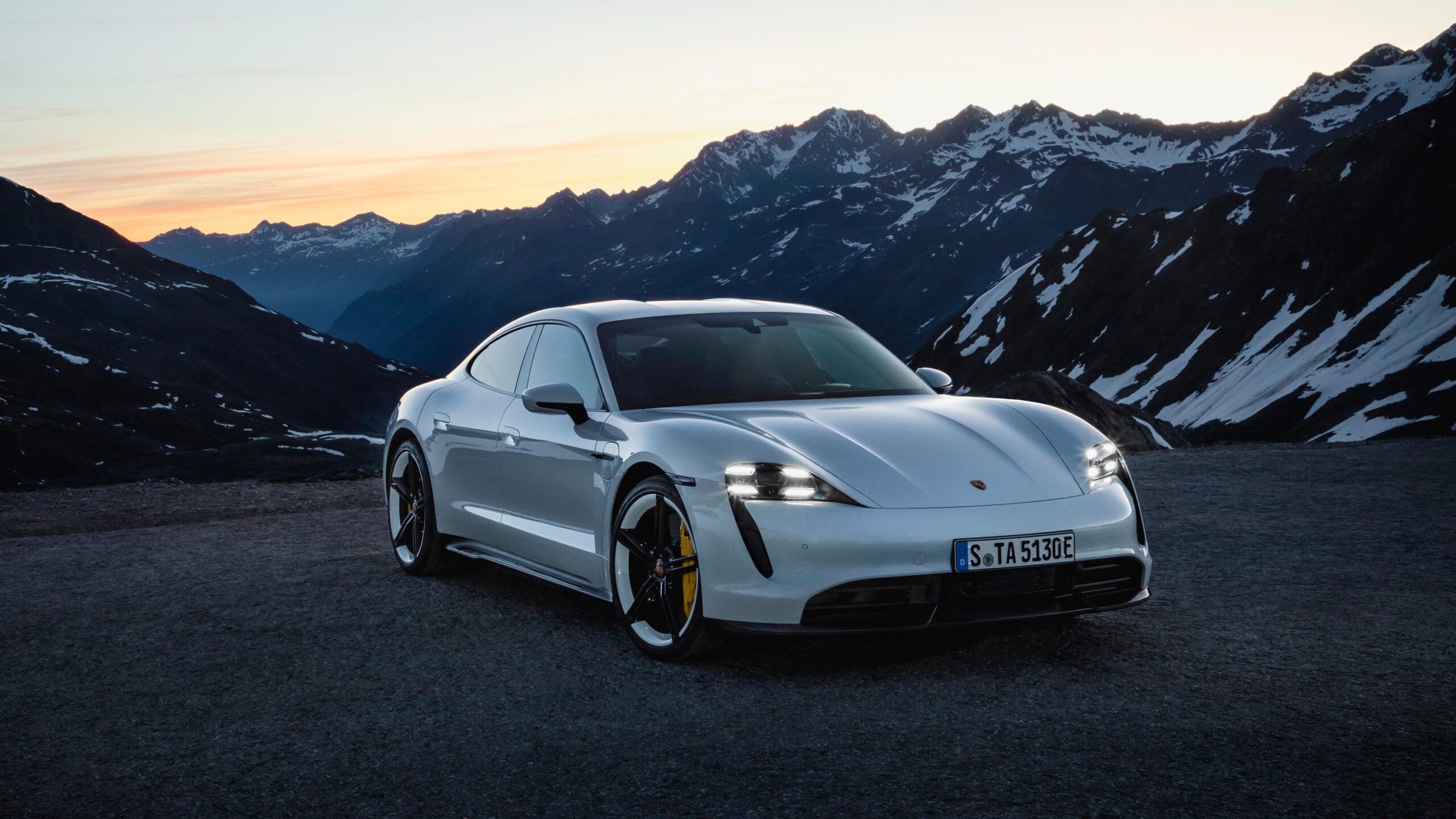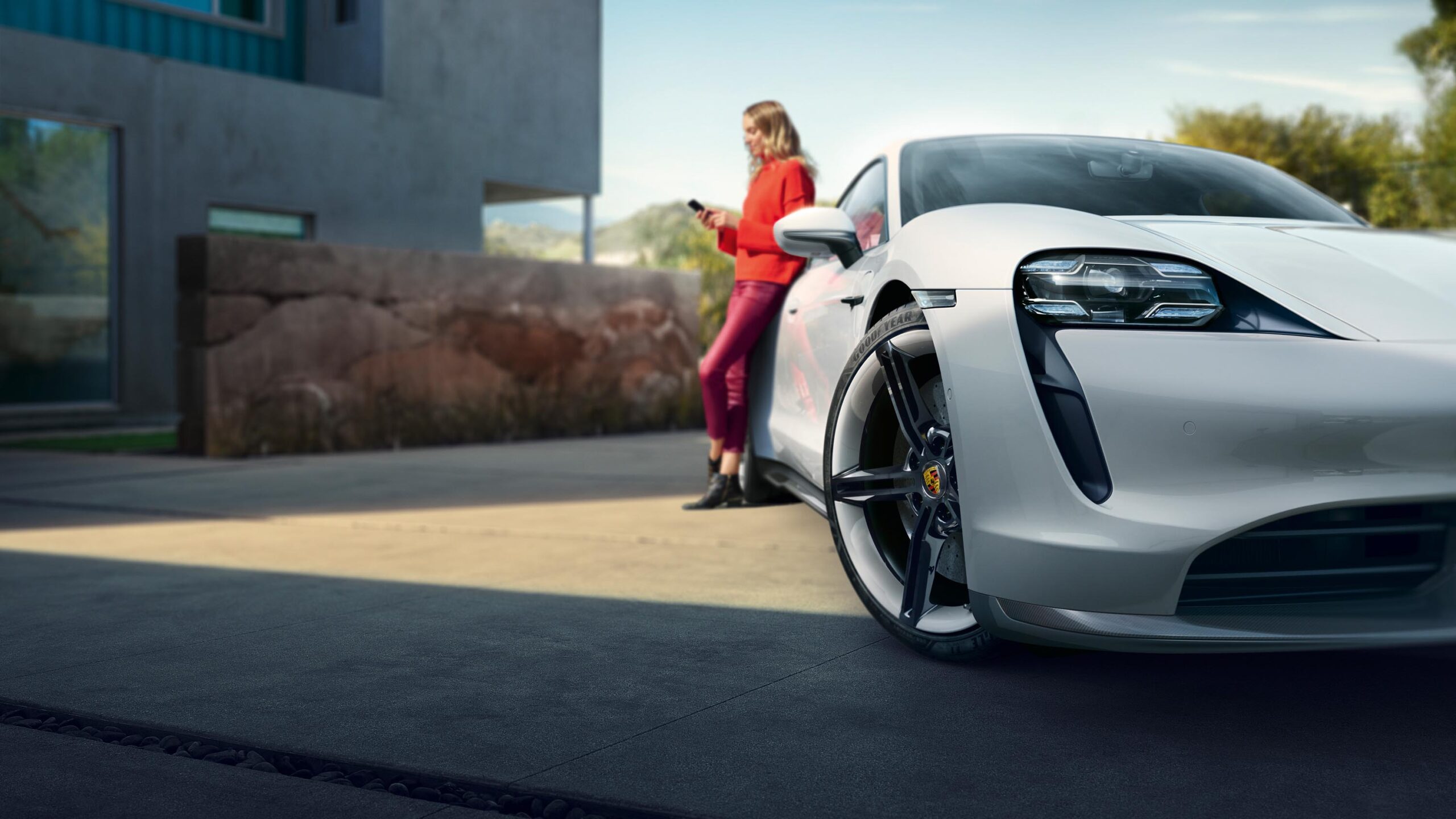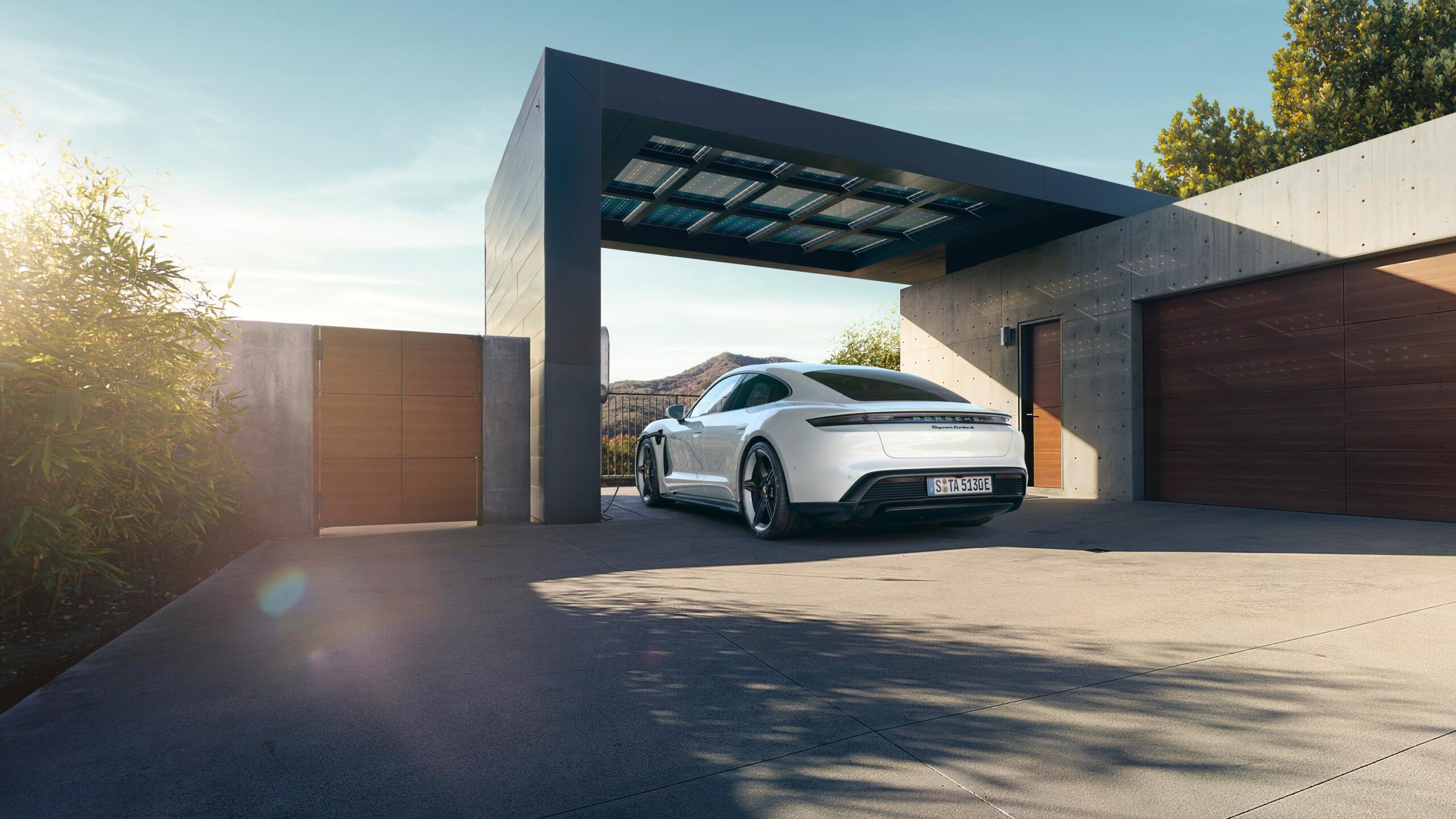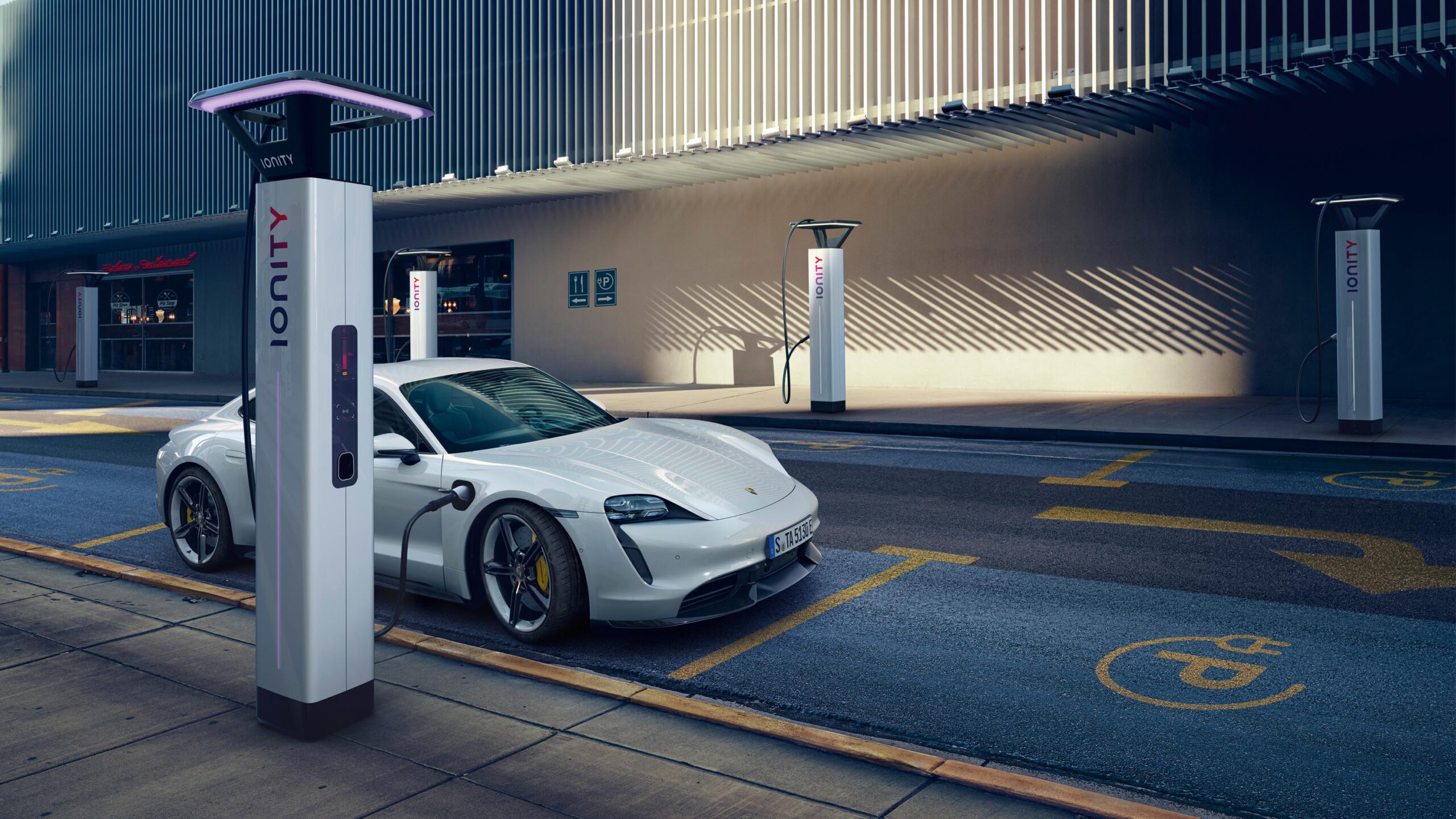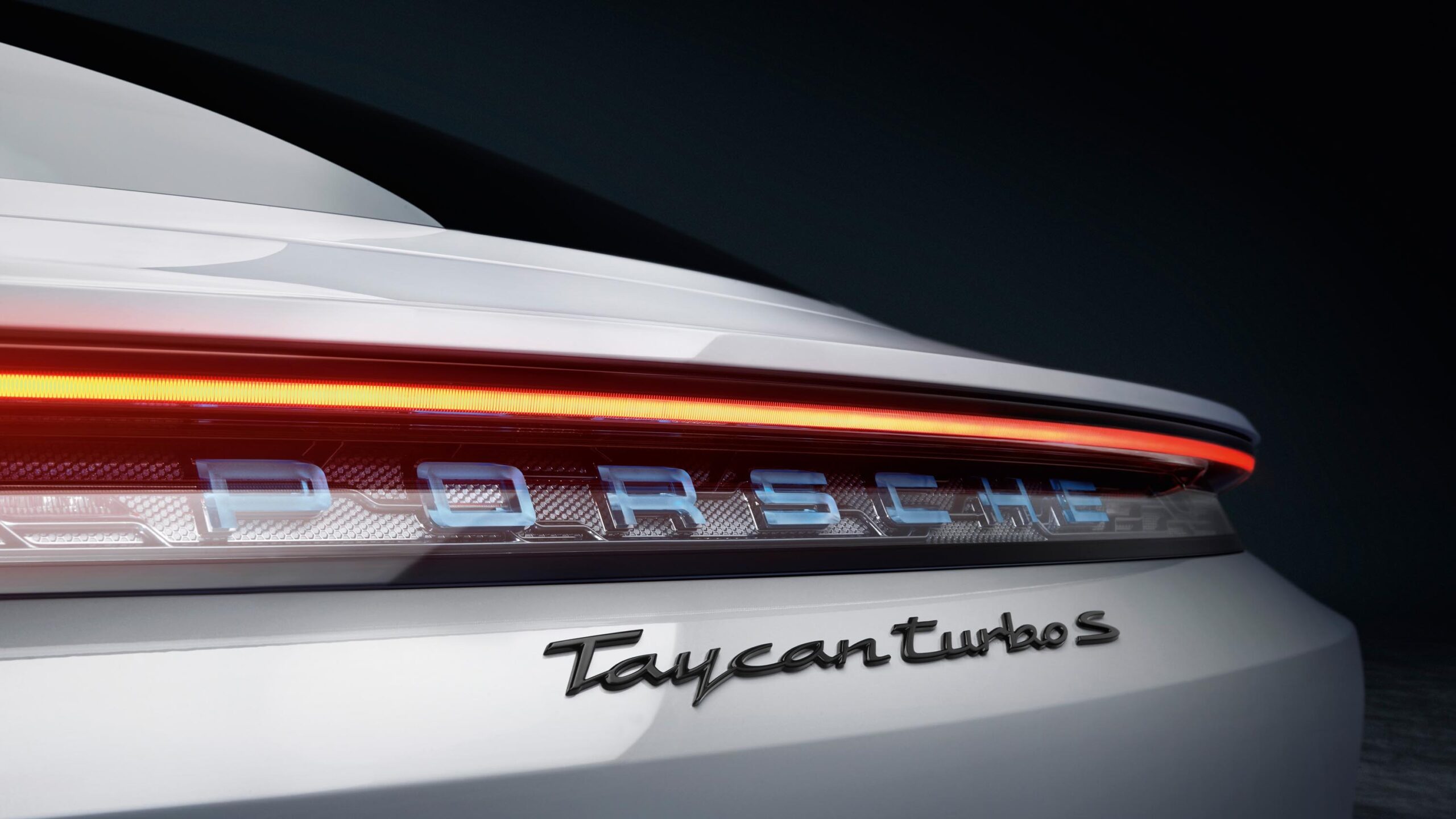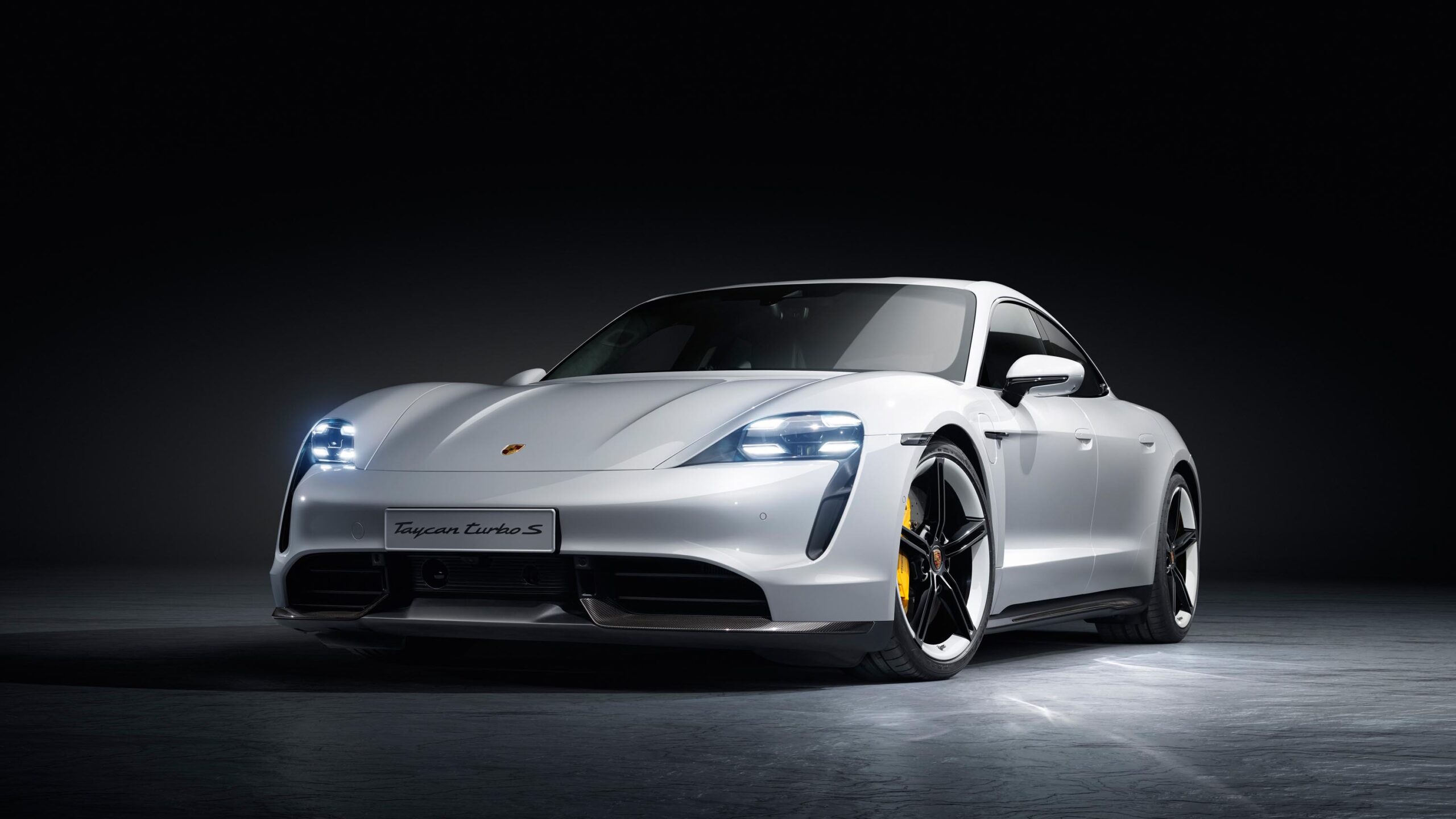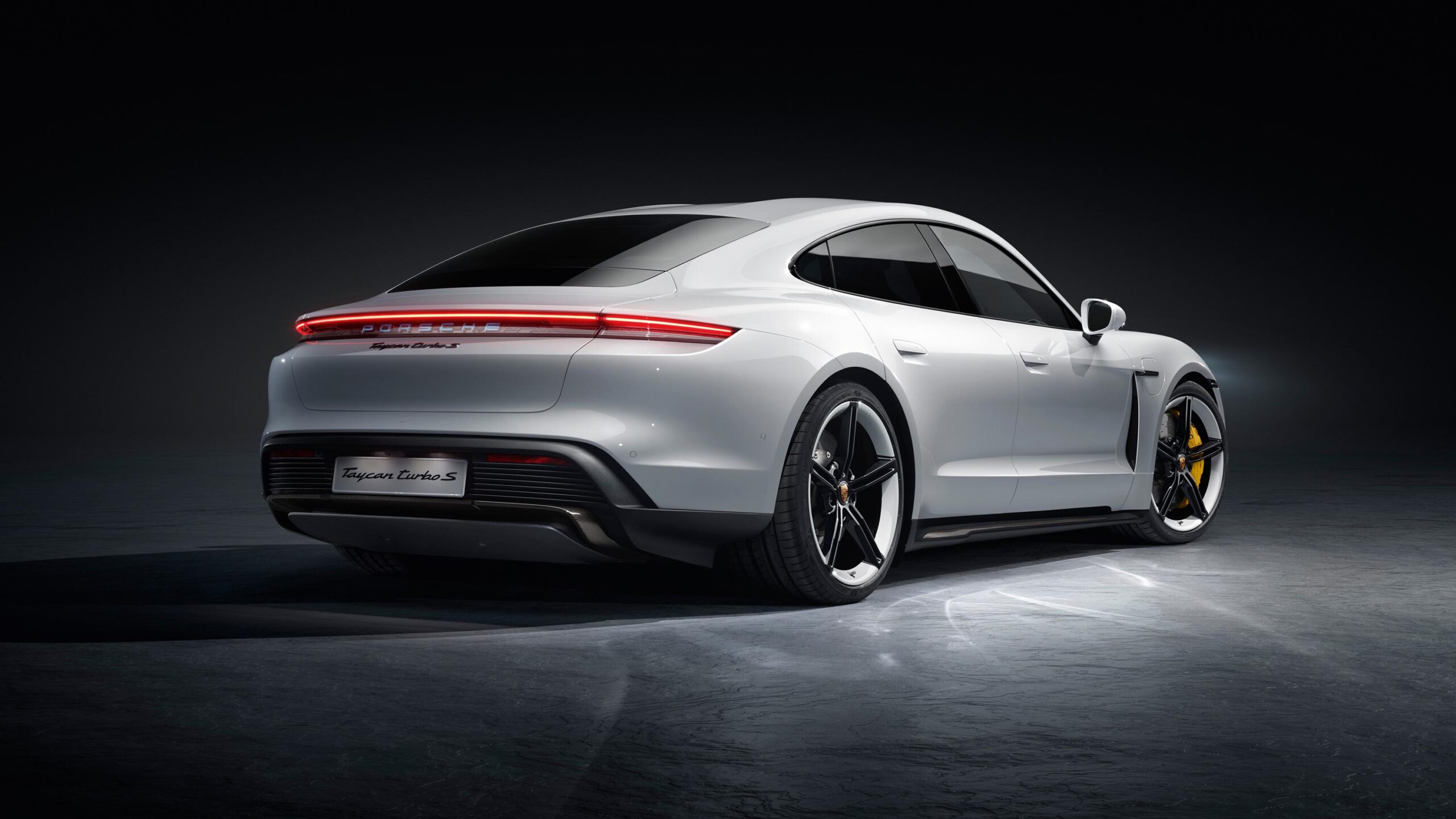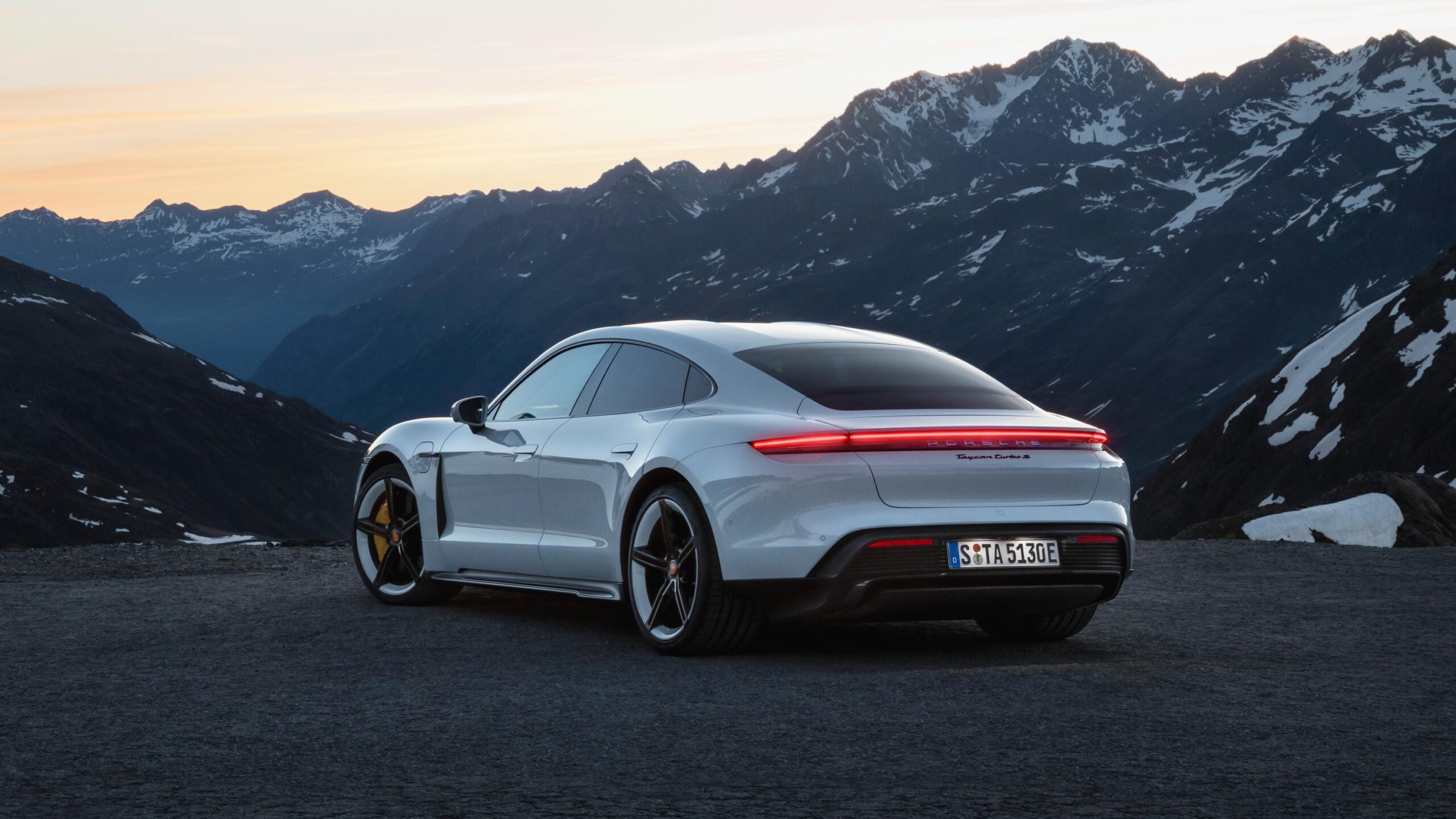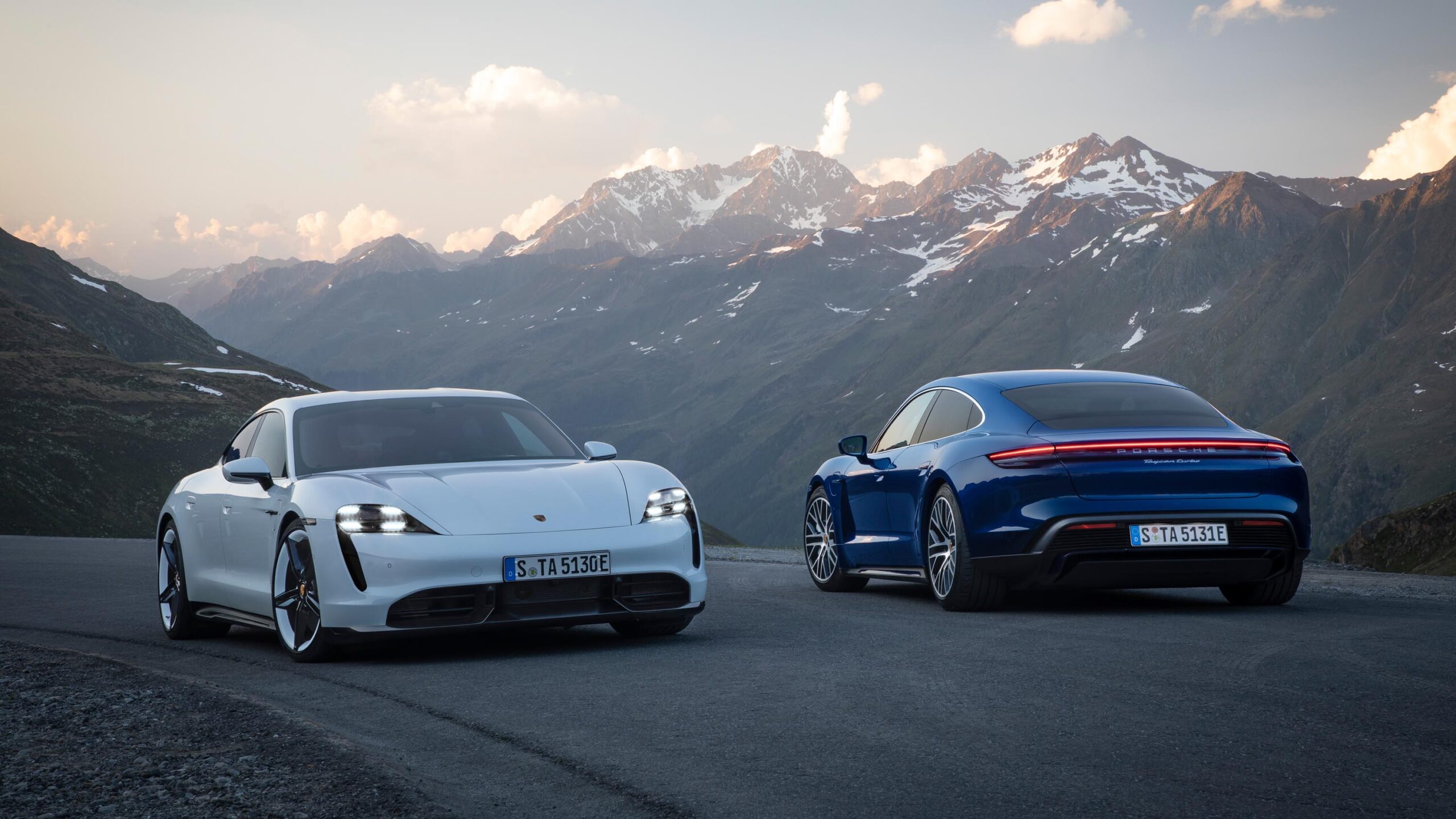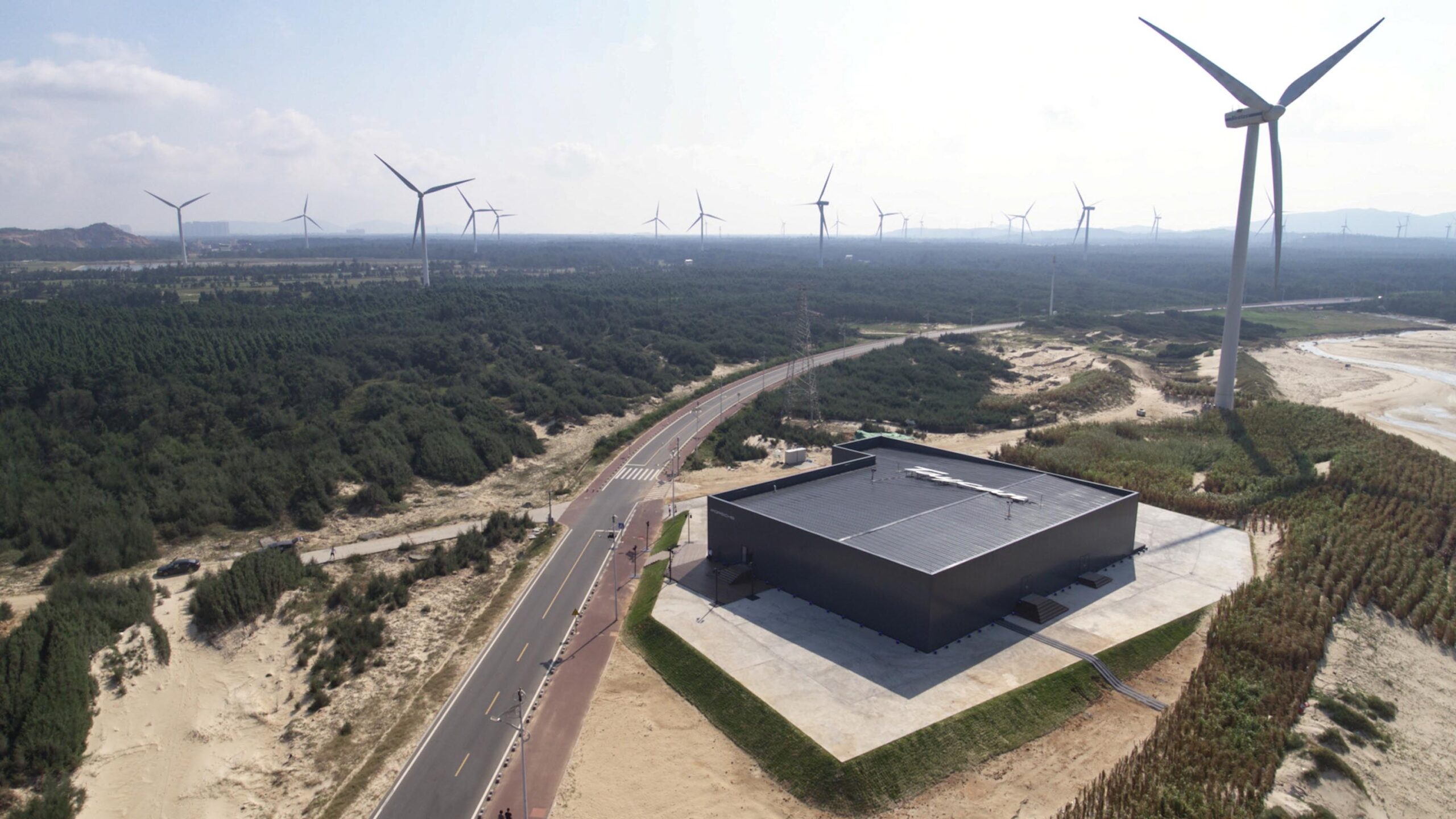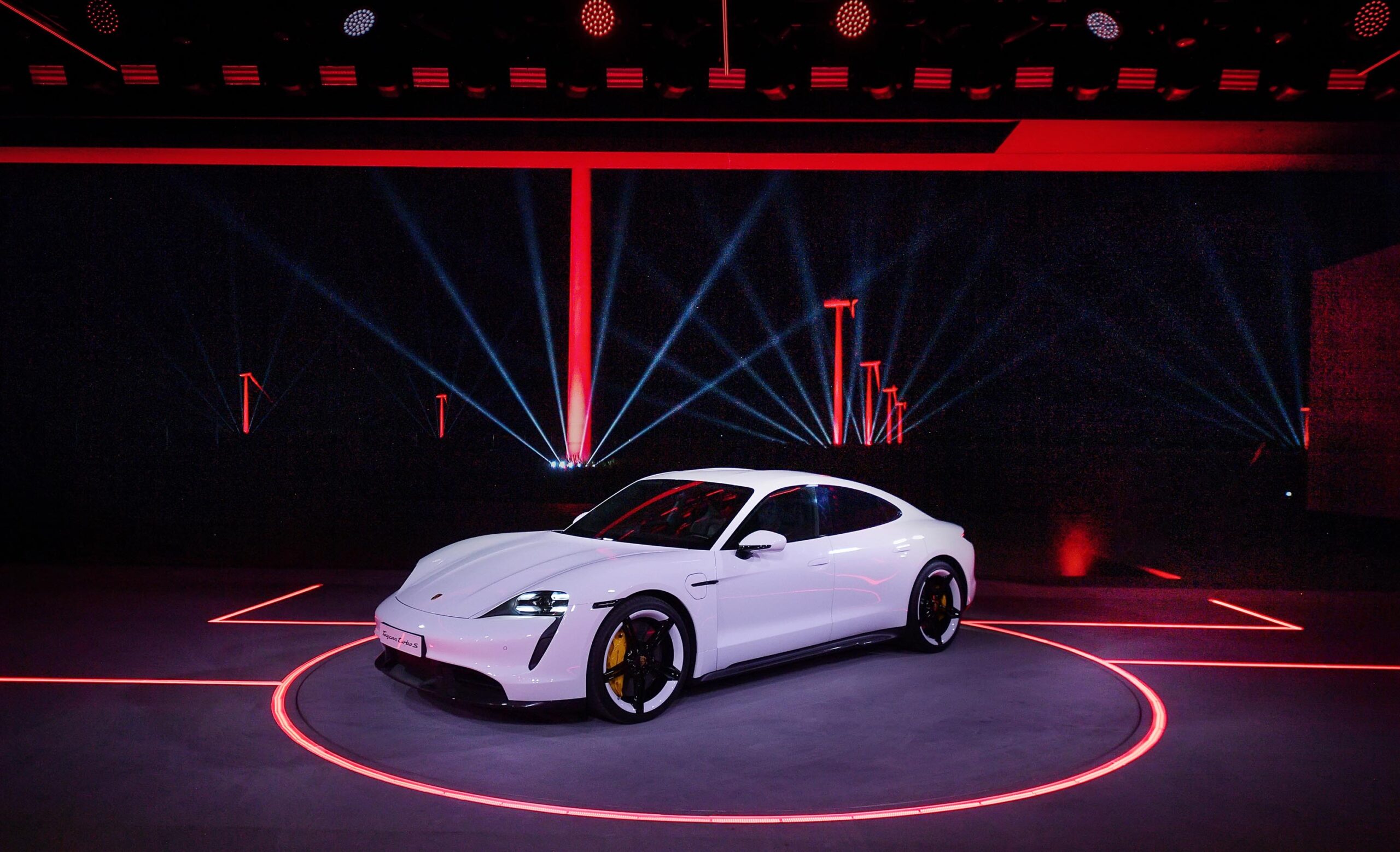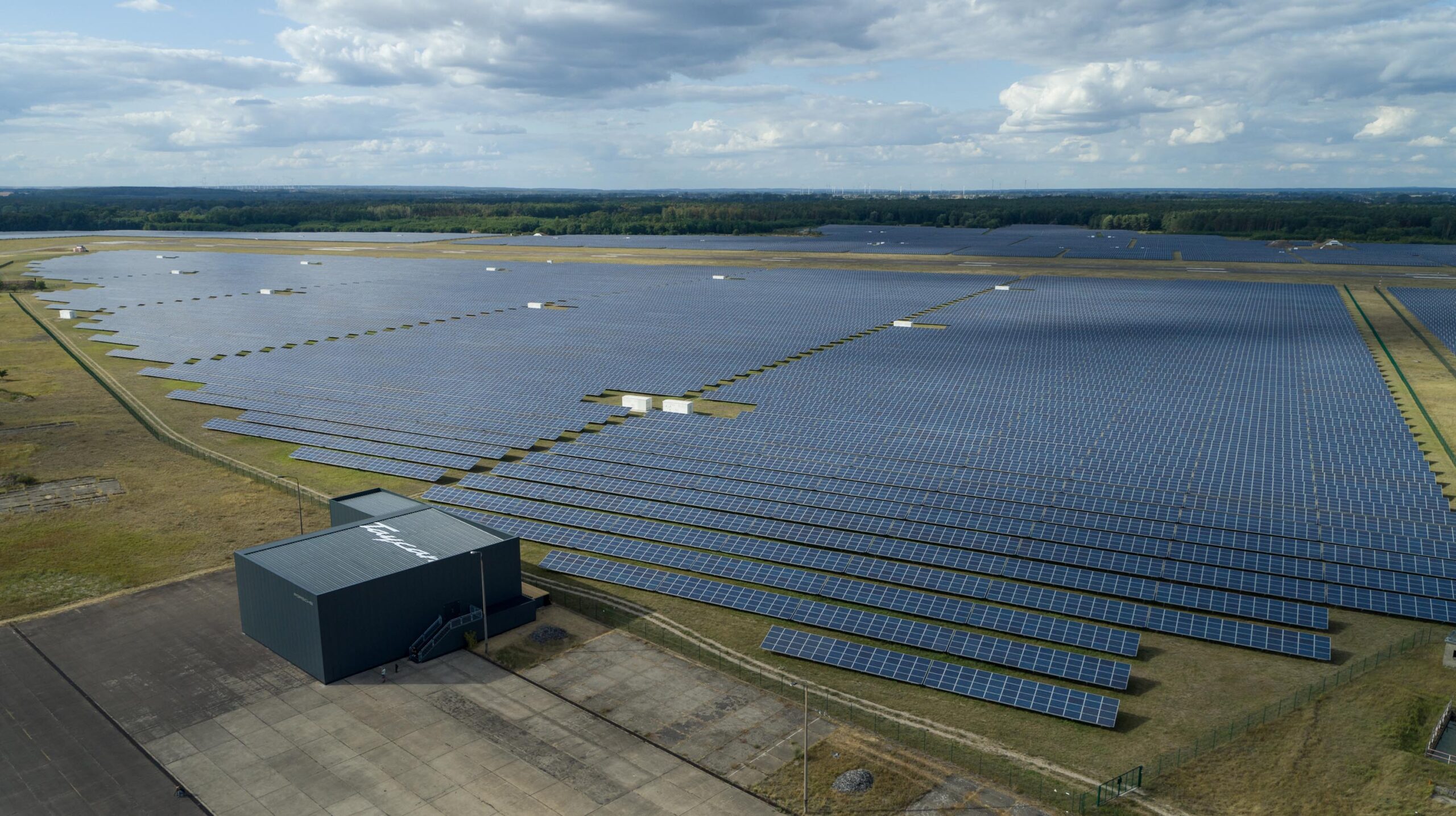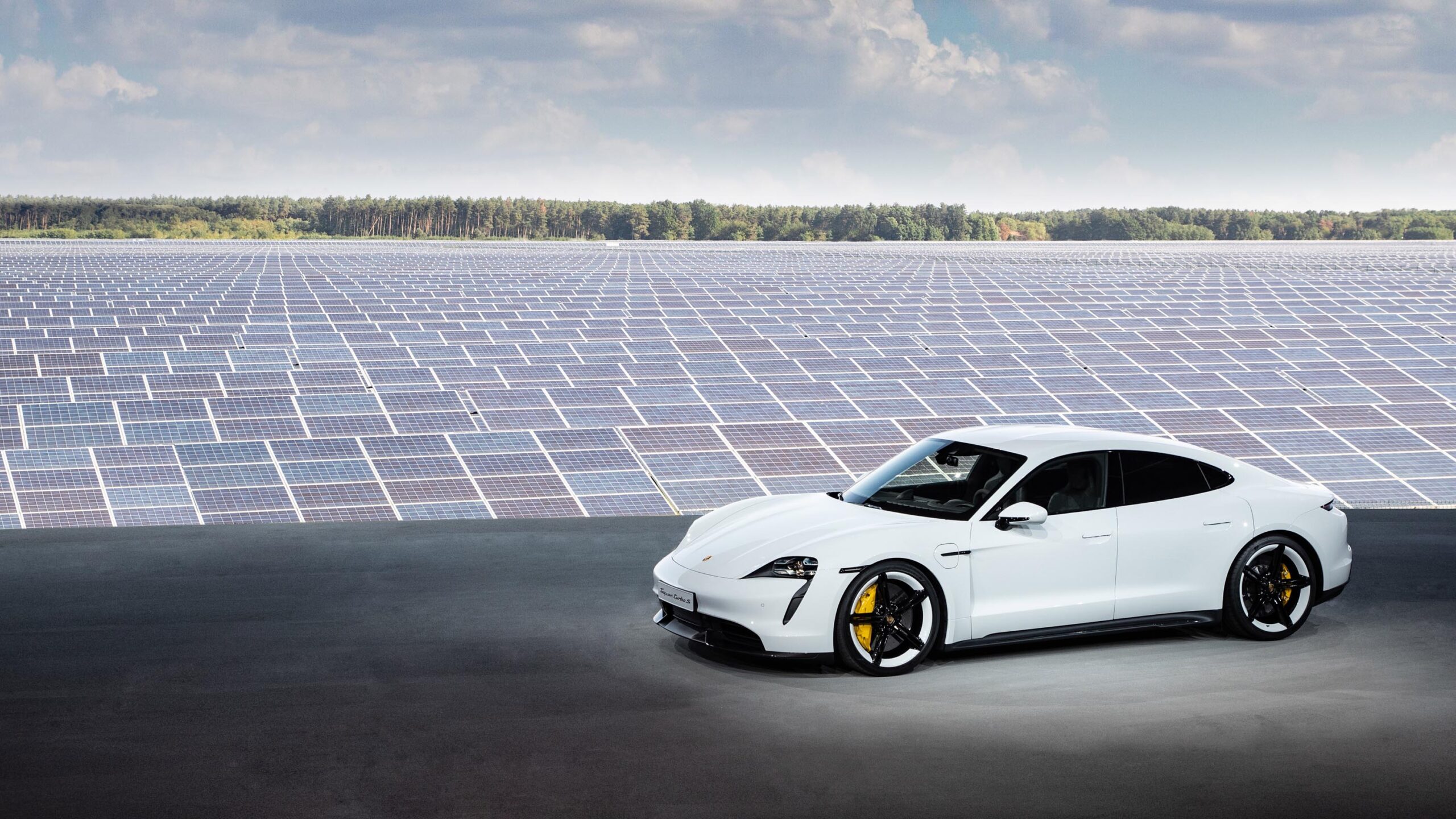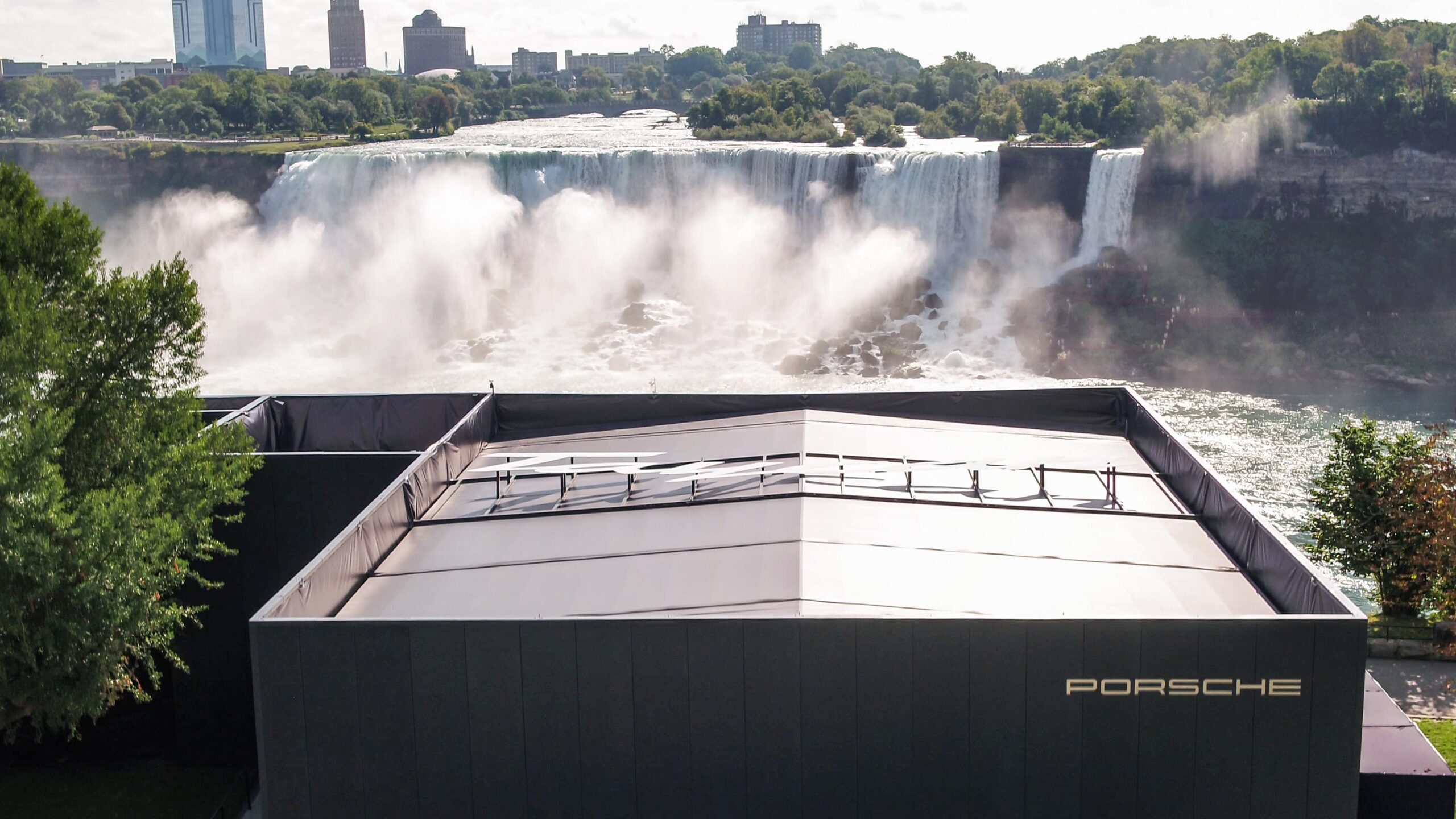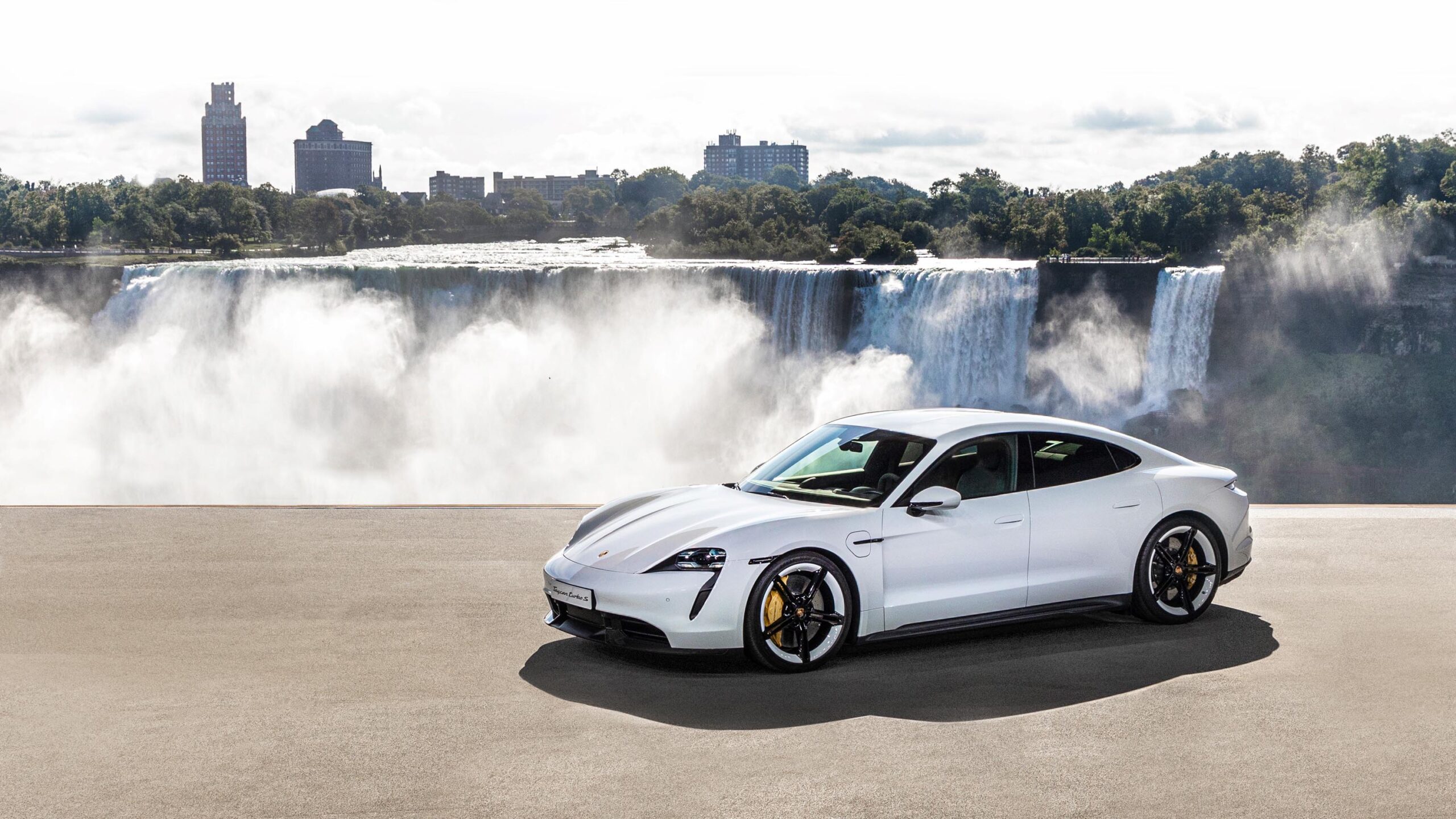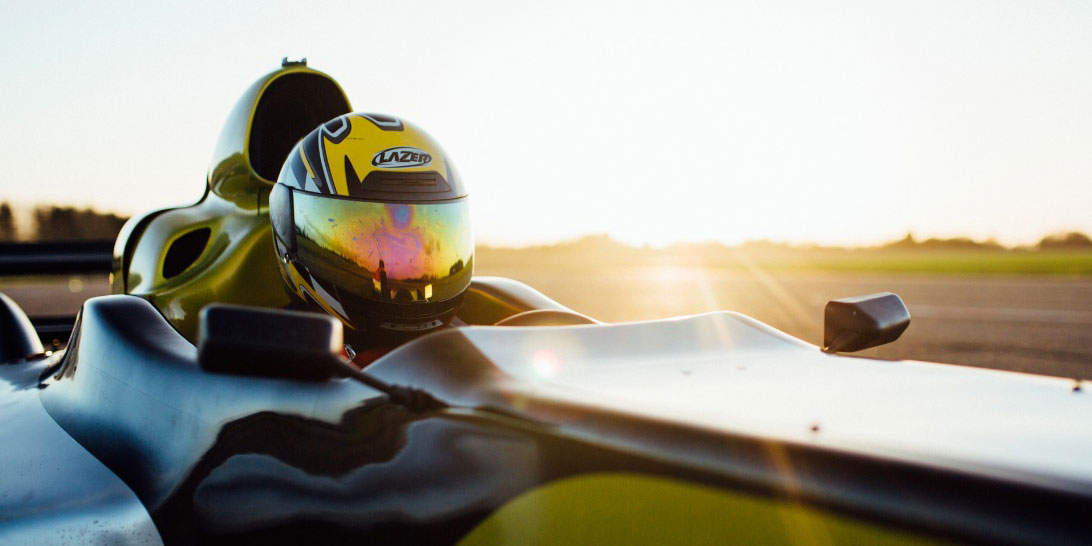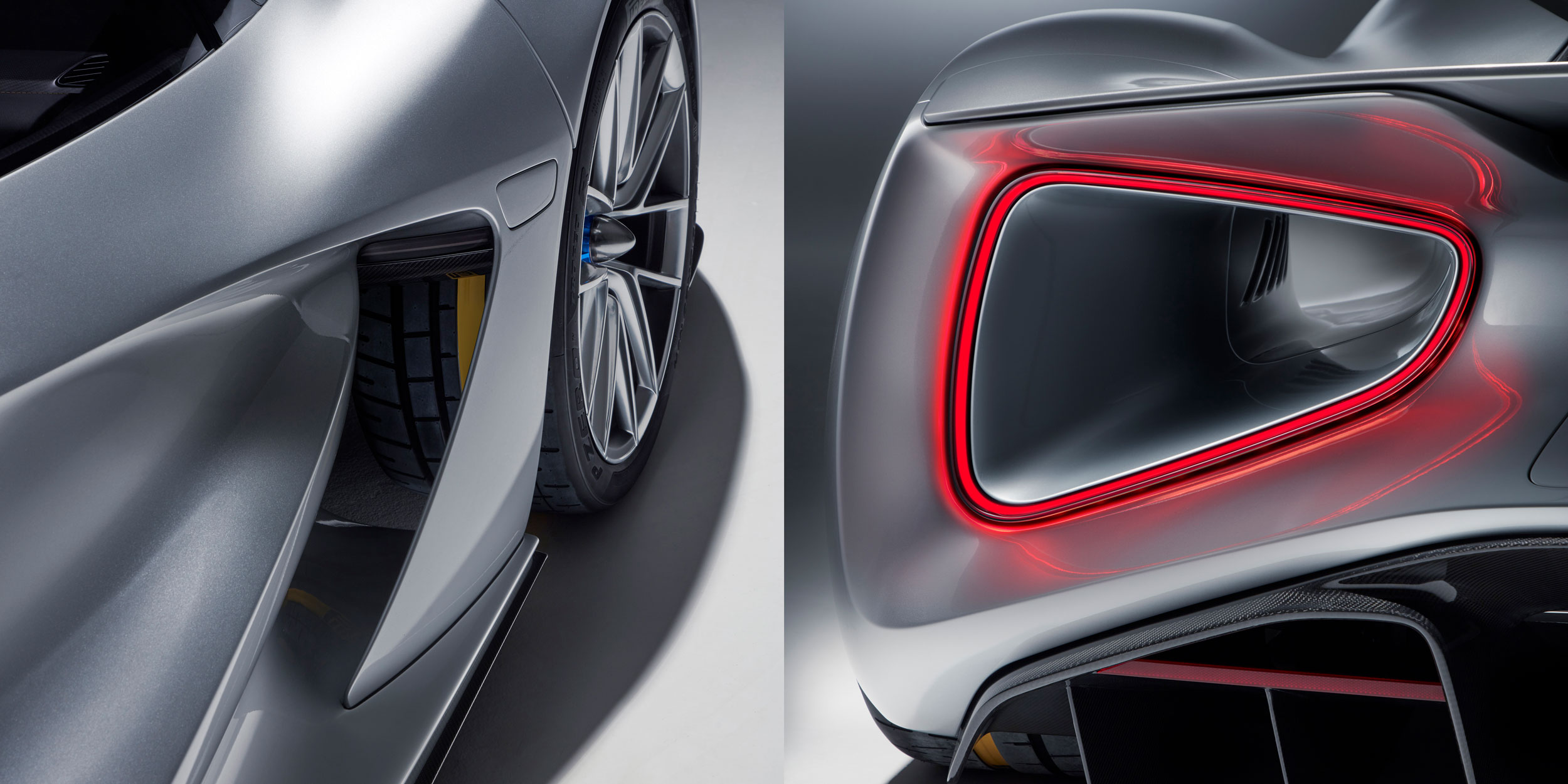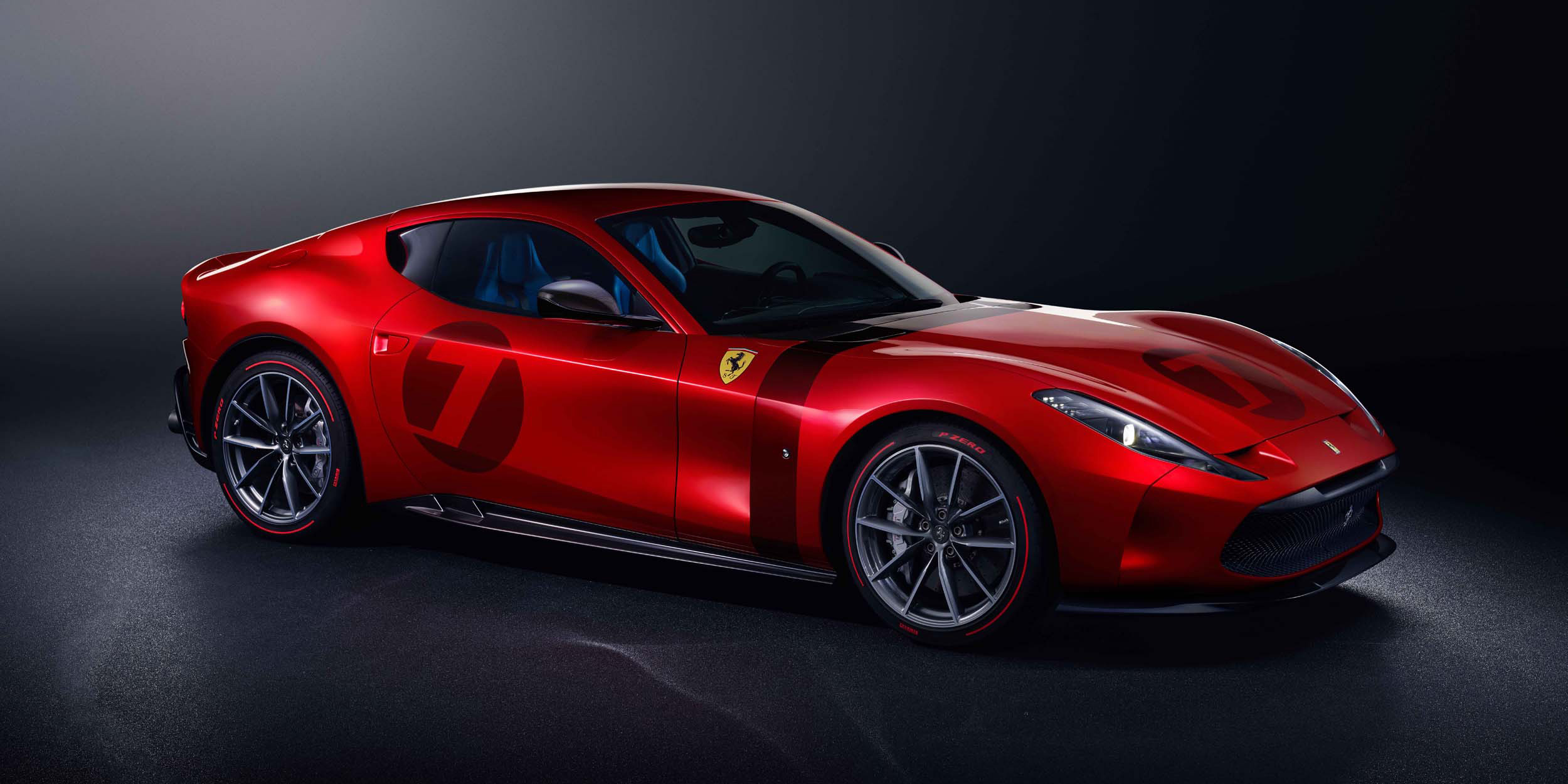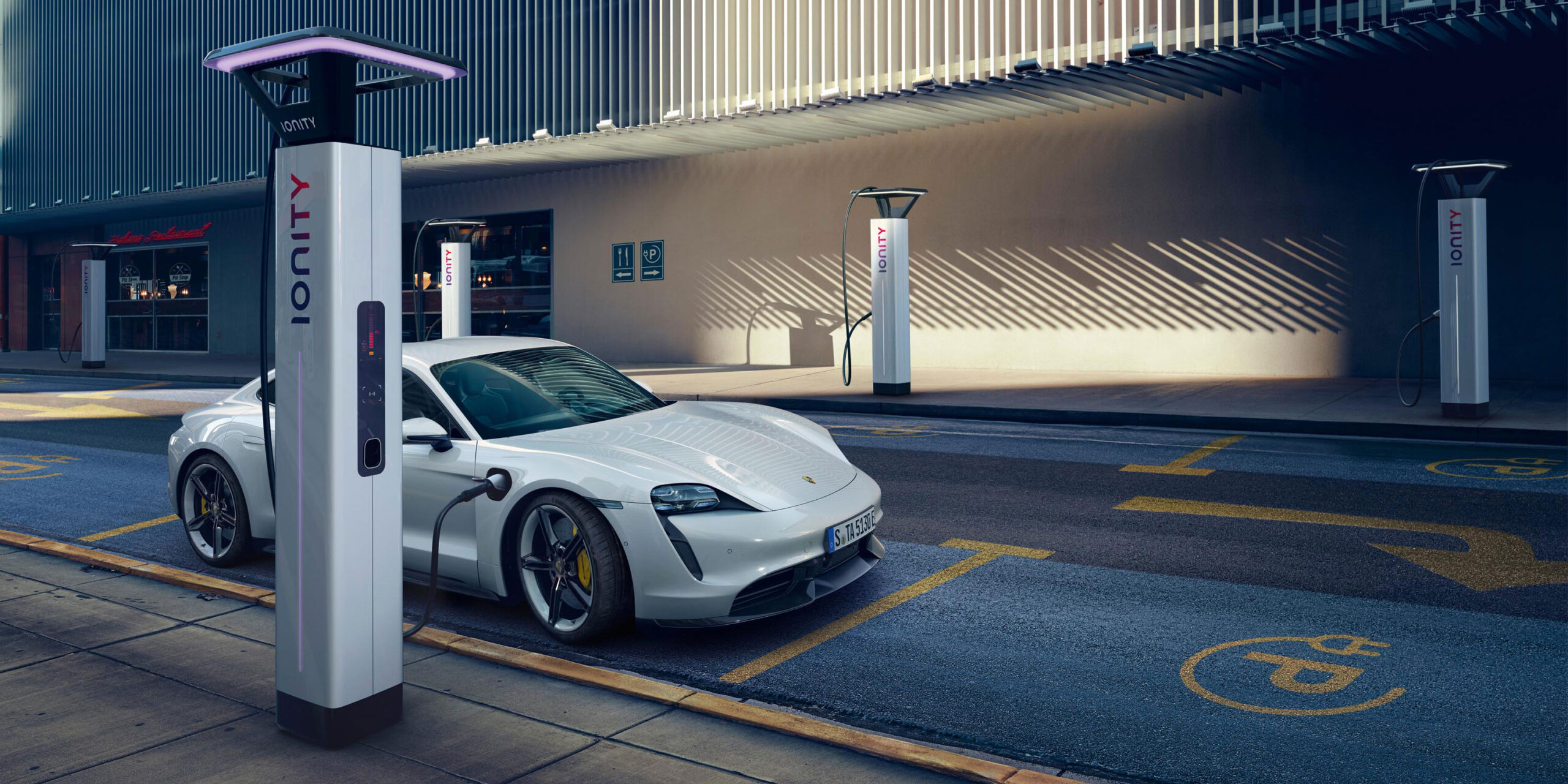
PURISTIC DESIGN AND FULLY-ELECTRIC DRIVE
Toronto/Berlin/Fuzhou. Porsche presented its first fully-electric sports car to the pub- lic today with a spectacular world premiere held simultaneously on three continents. “The Taycan links our heritage to the future. It carries forward the success story of our brand – a brand that has fascinated and thrilled people the world over for more than 70 years,” said Oliver Blume, Chairman of the Executive Board of Porsche AG, who opened the world premiere in Berlin: “This day marks the start of a new era.”
The four-door sports saloon is a unique package, offering typical Porsche performance and connectivity with everyday usability. At the same time, highly advanced production methods and the features of the Taycan are setting new standards in the fields of sus- tainability and digitalisation. “We promised a true Porsche for the age of electromobility – a fascinating sports car that not only excites in terms of its technology and driving dynamics, but also sparks a passion in people all over the world, just like its legendary predecessors have done. Now we are delivering on this promise,” emphasises Michael Steiner, Member of the Executive Board of Porsche AG – Research and Development.
The first models in the new series are the Taycan Turbo S and Taycan Turbo. They are at the cutting edge of Porsche E-Performance and are among the most powerful production models that the sports car manufacturer currently has in its product range. Less powerful variants of these all-wheel drive vehicles will follow this year. The first derivative to be added will be the Taycan Cross Turismo at the end of next year. By 2022, Porsche will have invested more than six billion euros in electromobility.
PERFORMANCE MEETS EFFICIENCY
The flagship Turbo S version of the Taycan can generate up to 560 kW (761 PS) over- boost power in combination with Launch Control, and the Taycan Turbo up to 500 kW (680 PS). The Taycan Turbo S accelerates from zero to 100 km/h in 2.8 seconds, while the Taycan Turbo completes this sprint in 3.2 seconds. The Turbo S has a range of up to 412 kilometres, and the Turbo a range of up to 450 kilometres (according to WLTP in each case). The top speed of both all-wheel-drive models is 260 km/h.
The Taycan is the first production vehicle with a system voltage of 800 volts instead of the usual 400 volts for electric cars. This is a particular advantage for Taycan drivers on the road: in just over five minutes, the battery can be recharged using direct cur- rent (DC) from the high-power charging network for a range of up to 100 kilometres (according to WLTP). The charging time for five to 80 percent SoC (state of charge) is 22.5 minutes for charging under ideal conditions, and the maximum charging power (peak) is 270 kW. The overall capacity of the Performance Battery Plus is 93.4 kWh. Taycan drivers can comfortably charge their cars with up to eleven kW of alternating current (AC) at home.
The Porsche Taycan Turbo S and Porsche Taycan Turbo are now available to order and cost 185,456 euros and 152,136 euros respectively in Germany, including country- specific equipment and VAT.
PURE EXTERIOR DESIGN WITH PORSCHE DNA
With its clean, puristic design, the Taycan signals the beginning of a new era. At the same time, it retains the unmistakable Porsche design DNA. From the front it looks particularly wide and flat with highly contoured wings. The silhouette is shaped by the sporty roofline sloping downward to the rear. The highly sculpted side sections are also characteristic. The sleek cabin, the drawn-in rear C-pillar and the pronounced shoul- ders of the wings result in a sharply emphasised rear, typical of the brand. There are “hairpin” winding of the stator coils. This technology makes it possible to incorporate more copper in the stator, increasing power output and torque while maintaining the same component volume. The two-speed transmission installed on the rear axle is an innovation developed by Porsche. First gear gives the Taycan even more acceleration from a standing start, while second gear with a long gear ratio ensures high efficiency and equally high power reserves. This also applies at very high speeds.
CENTRALLY NETWORKED CHASSIS SYSTEMS
Porsche uses a centrally networked control system for the Taycan chassis. The inte- grated Porsche 4D Chassis Control analyses and synchronises all chassis systems in real time. The innovative chassis systems include adaptive air suspension with three- chamber technology including PASM (Porsche Active Suspension Management) elec- tronic damper control, as well as the Porsche Dynamic Chassis Control Sport (PDCC Sport) electromechanical roll stabilisation system including Porsche Torque Vectoring Plus (PTV Plus). The all-wheel drive control with two electric motors and the recuper- ation system are unique. At up to 265 kW, the potential recuperation power is signifi- cantly higher than that of competitors. Driving tests have shown that approximately 90 percent of everyday braking is performed by the electric machines alone – without the hydraulic wheel brakes being activated.
The profile of the different driving modes basically follows the same philosophy as in other Porsche model series. This is supplemented by special settings which enable optimum use of the purely electric drive. Four driving modes are available: “Range”, “Normal”, “Sport” and “Sport Plus”. In addition, individual systems can be configured as required in the “Individual” mode.
A WORLD PREMIERE ON THREE CONTINENTS AT THE SAME TIME
The Porsche Taycan’s world premiere took place simultaneously in North America, China and Europe. The most important sales markets of the new electric sports car are on these three continents. The event locations are also a synonym for three ways of sustainable energy management: Niagara Falls at the border between the US state of New York and the Canadian province of Ontario representing hydro-power, a solar farm in Neuhardenberg near Berlin representing solar power and a wind farm on Ping- tan Island, around 150 kilometres from the Chinese city of Fuzhou in the province of Fujian representing wind power. We perceive these natural forces with all our senses in exactly the same way as we experience the impressive power delivery of the first all-electric sports car from Porsche. This one-time triple event was broadcast world- wide via live stream on NewsTV.porsche.com.
Taycan Turbo
| Drive System |
|
| Battery |
Performance battery plus with 93.4 kWh |
| Electric motor, front axle |
Permanently excited synchronous motor |
| Electric motor, rear axle |
Permanently excited synchronous motor |
| Transmission, front axle |
Single-speed transmission |
| Transmission, rear axle |
Two-speed transmission |
| Drive system |
Electric all-wheel drive with adjustable momentum distribution and Porsche Traction Management (PTM) |
| Power Output |
up to 460 kW (625 PS) |
| Overboost power for Launch Control |
up to 500 kW (680 PS) |
| Maximum torque for Launch Control |
850 Nm |
| Chassis |
|
| Suspension and damping |
Adaptive air suspension with three-chamber air springs including Porsche Active Suspension Management (PASM) |
| Front axle |
Aluminium double wishbone front axle, independent suspension |
| Rear axle |
Aluminium multi-link rear axle, independent suspension |
| Steering |
Power steering; also available with rear axle steering (RAS) with power steering plus |
| Steering ratio |
15.5:1 (centre position) to 9.3:1; with RAS 14.2:1 (centre position) to 9.3:1 |
| Turning circle diameter |
11.7 m; with RAS 11.2 m |
| Vehicle stability system |
Porsche Stability Management (PSM) with ABS and extended brake functionalities |
| Brakes |
|
| Brake system |
Ten-piston aluminium monobloc fixed caliper brakes at the front, four-piston aluminium monobloc fixed caliper brakes at the rear; electric parking brake; multi-collision brake; auto-hold function |
| Brake discs, front axle |
Porsche Surface Coated Brake (PSCB); with tungsten carbide-coated cast-iron brake discs, internally ventilated |
| Diameter |
415 mm |
| Thickness |
40 mm |
| Brake discs, rear axle |
Porsche Surface Coated Brake (PSCB); with tungsten carbide-coated cast-iron brake discs, internally ventilated |
| Diameter |
365 mm |
| Thickness |
28 mm |
| Wheels and tyres |
|
| Wheels with tyres, front |
9.0 J × 20 ET 54 with 245/45 R 20 103Y XL tyres |
| Wheels with tyres, rear |
11.0 J × 20 ET 60 with 285/40 R 20 108Y XL tyres |
| Dimensions |
|
| Length |
4,963 mm |
| Width (with exterior mirrors) |
1,966 mm (2,144 mm) |
| Height |
1,381 mm |
| Wheelbase |
2,900 mm |
| Track width, front |
1,702 mm |
| Track width, rear |
1,667 mm |
| Luggage compartment volumes and weights |
|
Luggage compartment volumes
(rear/front)
|
366 l/81 l |
| Unladen weight according to DIN |
2,305 kg |
| Permissible gross weight |
2,880 kg |
| Permissible roof load (with Porsche roof transport system) |
75 kg |
| Performance |
|
| Top speed |
260 km/h |
Acceleration with Launch Control
0 – 60 mph
|
3.0 s |
| 0–100 km/h |
3.2 s |
| 0–160 km/h |
6.9 s |
| 0 – 200 km/h |
10.6 s |
| 0 – 400 m (1/4 miles) |
11.1 s |
| Distance after 2.5 seconds |
25.5 m |
| Range, consumption, emissions |
|
| Range (min.–max. WLTP) |
381 – 450 km |
Power consumption
(min.–max. WLTP)
|
26.7 – 23.0 kWh/100 km |
| Power consumption (NEDC combined) |
26.0 kWh/100 km |
| CO2 emissions |
0 g/km |
| Efficiency class Germany |
A+ |
| Charging |
|
| Maximum DC charging capacity |
270 kW |
| Charging time for alternating current (AC) at 11 kW from 0 to up to 100% |
9.0 hours |
| Charging time for direct current (DC) at 50 kW for up to 100 km (WLTP) |
28 min |
| Charging time for direct current (DC) at 270 kW for up to 100 km (WLTP) under optimum conditions |
5 min |
| Charging time for direct current (DC) at 50 kW from 5 to up to 80% |
93 min |
| Charging time for direct current (DC) at 270 kW from 5 to up to 80% under optimum conditions |
22.5 min |
| Aerodynamics |
|
| <strong>Drag coefficient Cd</strong> (in Range mode in combination with a low level and closed air intake flaps) |
0.22 |
| Frontal area A |
2.33 m2 |
| Cd x A |
0.513 m2 |
Taycan Turbo S
| Drive System |
|
| Battery |
Performance battery plus with 93.4 kWh |
| Electric motor, front axle |
Permanently excited synchronous motor |
| Electric motor, rear axle |
Permanently excited synchronous motor |
| Transmission, front axle |
Single-speed transmission |
| Transmission, rear axle |
Two-speed transmission |
| Drive system |
Electric all-wheel drive with adjustable momentum distribution and Porsche Traction Management (PTM) |
| Power Output |
up to 460 kW (625 PS) |
| Overboost power for Launch Control |
up to 560 kW (761 PS) |
| Maximum torque for Launch Control |
1,050 Nm |
| Chassis |
|
| Suspension and damping |
Adaptive air suspension with three-chamber air springs including Porsche Active Suspension Management (PASM) |
| Front axle |
Aluminium double wishbone front axle, independent suspension |
| Rear axle |
Aluminium multi-link rear axle, independent suspension |
| Steering |
Rear axle steering (RAS) with power steering plus |
| Steering ratio |
14.2:1 (centre position) to 9.3:1; |
| Turning circle diameter |
11.2 m |
| Vehicle stability system |
Porsche Stability Management (PSM) with ABS and extended brake functionalities |
| Brakes |
|
| Brake system |
Ten-piston aluminium monobloc fixed caliper brakes at the front, four-piston aluminium monobloc fixed caliper brakes at the rear; electric parking brake; multi-collision brake; auto-hold function |
| Brake discs, front axle |
Porsche Ceramic Composite Brake (PCCB); ceramic brake discs, internally ventilated |
| Diameter |
420 mm |
| Thickness |
40 mm |
| Brake discs, rear axle |
Porsche Ceramic Composite Brake (PCCB); ceramic brake discs, internally ventilated |
| Diameter |
410 mm |
| Thickness |
32 mm |
| Wheels and tyres |
|
| Wheels with tyres, front |
9.5 J x 21 ET 60 with 265/35 ZR 21 101Y XL tyres |
| Wheels with tyres, rear |
11.5 J x 21 ET 66 with 305/30 ZR 21 104Y XL tyres |
| Dimensions |
|
| Length |
4,963 mm |
| Width (with exterior mirrors) |
1,966 mm (2,144 mm) |
| Height |
1,378 mm |
| Wheelbase |
2,900 mm |
| Track width, front |
1,690 mm |
| Track width, rear |
1,655 mm |
| Luggage compartment volumes and weights |
|
Luggage compartment volumes
(rear/front)
|
366 l/81 l |
| Unladen weight according to DIN |
2,295 kg |
| Permissible gross weight |
2,870 kg |
| Permissible roof load (with Porsche roof transport system) |
75 kg |
| Performance |
|
| Top speed |
260 km/h |
Acceleration with Launch Control
0 – 60 mph
|
2.6 s |
| 0–100 km/h |
2.8 s |
| 0–160 km/h |
6.3 s |
| 0 – 200 km/h |
9.8 s |
| 0 – 400 m (1/4 miles) |
10.8 s |
| Distance after 2.5 seconds |
28.0 m |
| Range, consumption, emissions |
|
| Range (min.–max. WLTP) |
388 – 412 km |
Power consumption
(min.–max. WLTP)
|
25.7 – 24.5 kWh/100 km |
| Power consumption (NEDC combined) |
26.9 kWh/100 km |
| CO2 emissions |
0 g/km |
| Efficiency class Germany |
A+ |
| Charging |
|
| Maximum DC charging capacity |
270 kW |
| Charging time for alternating current (AC) at 11 kW from 0 to up to 100% |
9.0 hours |
| Charging time for direct current (DC) at 50 kW for up to 100 km (WLTP) |
31 min |
| Charging time for direct current (DC) at 270 kW for up to 100 km (WLTP) under optimum conditions |
5.5 min |
| Charging time for direct current (DC) at 50 kW from 5 to up to 80% |
93 min |
| Charging time for direct current (DC) at 270 kW from 5 to up to 80% under optimum conditions |
22.5 min |
| Aerodynamics |
|
| Drag coefficient Cd (in Range mode in combination with a low level and closed air intake flaps) |
0.25 |
| Frontal area A |
2.33 m2 |
| Cd x A |
0.583 m2 |

